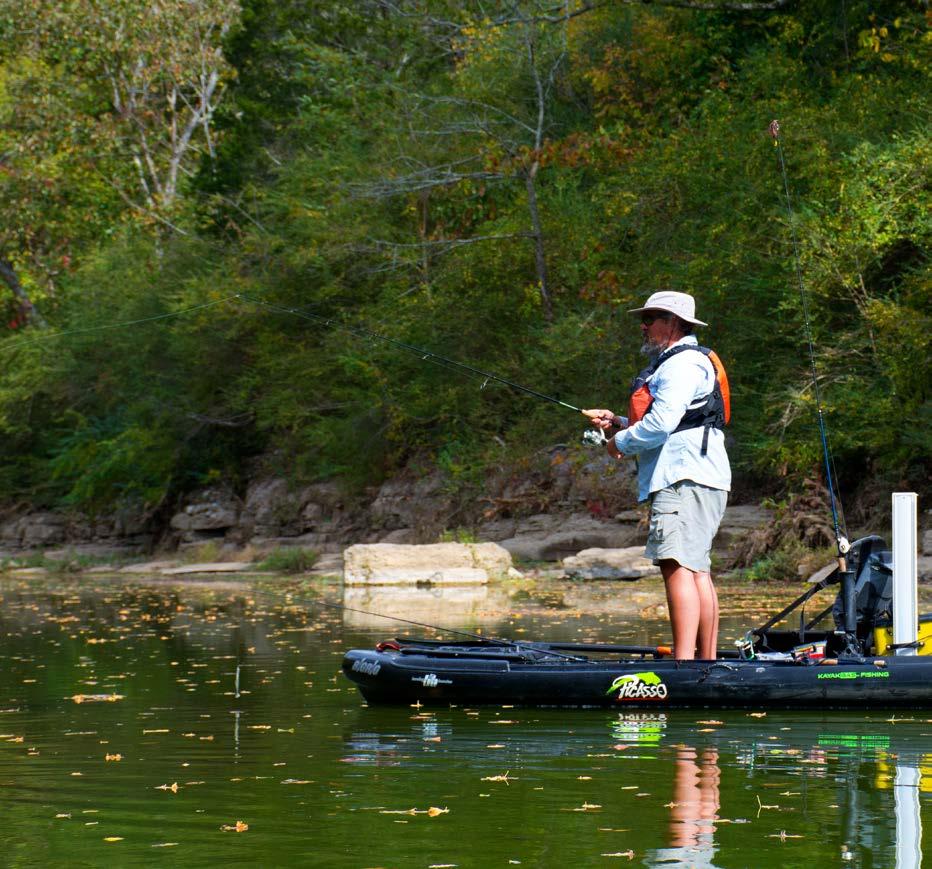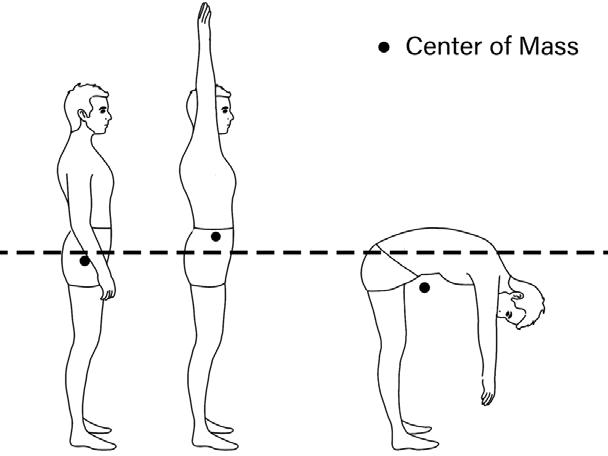
6 minute read
The Core of Balance by Donald Dehm

Photo by Chris Funk
The Core of Balance by Donald Dehm
Advertisement
Learning to stand in a kayak is one thing, maintaining your balance while standing in a kayak is something that you must practice on and off the water.
Most fishing kayak manufacturers have at least one kayak model that is designed with standing in mind. Over the last few years, standing in a kayak has become a desire of the angler; this desire has driven the design to meet these demands. While there are many videos, articles, and tutorials on how to stand up and sit down in a kayak, this article is about how to keep your balance while you are standing and how you can improve your balance to allow you to stand longer with more confidence and with less fatigue to your knees and back.
BALANCE BIOMECHANICS Keeping one’s balance on a kayak requires understanding what balance is, what sway is, what center of mass is, and how it all comes together when we talk about the human body. So, what are balance, sway, and center of mass for the human body?
“In biomechanics, balance is an ability to maintain the line of gravity (vertical line from center of mass) of a body within the base of support with minimal postural sway. Sway is the horizontal movement of the center of gravity even when a person is standing still. A certain amount of sway is essential and inevitable due to small perturbations within the body (e.g., breathing, shifting body weight from one foot to the other or from forefoot to rearfoot) or from external triggers (e.g., visual distortions, floor translations).”

The Center of Mass in the body changes as you move. The figure on left is with feet spread wide apart, the middle is with arms raised, and the far right is bent forward. Notice how the Center of Mass is affected as you move and change position.
Image Courtesy of Kelsey Hoggard
The center of mass of the body, when standing, is roughly in the middle of the body, just below the belly button level. It is directly over the base of support, the area between your feet.
This changes with movements, body type (height/ build), what we are holding or doing (paddle, rod, casting, etc.), and what we are wearing (clothes/PFD).
Imagine you’re standing still, now slowly lean forward, you will reach the point when you lose balance and have to step forward to catch yourself from falling; this is the point at which your center of mass is no longer over your base of support.
BIOMECHANICS IN THE KAYAK ANGLER When we, as kayak anglers, allow the center of mass to go outside the base of support is when we risk falling into the water. The bigger/wider the base of support, the easier it is to balance; standing with legs as far apart as possible on the deck.
The closer the center of mass is to the base of support, the easier it is to balance; crouching or sitting down in the seat.
Sway comes into play for us kayak anglers in many forms which include the water/wave movement, the flexing of the hull/deck, fatigue, body sensory (joints, head motion vs. body motion, directional information as it relates to the head position), rotation from casting/setting hooks/paddling, bending over to land fish, etc.
CONTROLLING YOUR BALANCE There are two ways of controlling your balance, involuntary and voluntary. Most individuals have some level of involuntary control of balance (automatic), and this level varies from person to person and is extremely difficult to improve upon.
Voluntary control of balance (learned) levels vary in us all, but fortunately, we can improve these levels greatly with practice and training. Of course, there are psychological and physical factors that can limit each of these two areas, but we can all reach our full potential if we work hard towards improving ourselves.
ENGAGE YOUR CORE The key to maintaining your balance while in the kayak comes down to using your core muscles and legs. Your legs are used as shock absorbers and to help mitigate the sway caused by the water/kayak moving.
•Keep your feet as far apart in the kayak as possible. •Keep your knees slightly bent and relaxed, do not lock your knees. •Keep your legs slightly relaxed to allow you to shift the weight of your body from one to the other, or both as dictated by the sway motions. •Engage your core muscles to trigger your voluntary and involuntary control of balance to help keep the center of mass over your base of support.
Practicing your balance can help you gain the confidence to not only fish standing up, but also to paddle while standing.

Kayak Fishing Quarterly PRACTICING YOUR BALANCE These are exercises and techniques that can help you with your voluntary control of balance, that you can perform when not in the kayak. •Stand with your eyes closed and focus on engaging your core to maintain balance. •Stand on a bottom stair with heels or toes off the edge. Practice maintaining balance with eyes open. •Next, close your eyes and see how well you can maintain that balance (remember to engage your core). •Balance on one foot and bend slightly forward at the waist with your eyes open. When you feel confident in that, do it with your eyes closed. This is great for learning to keep balance while paddling. You can hold a paddle to help give you a sense of real-life application if desired. •Balance on one foot and simulate casting and setting the hook with a rod in your hand. Engage your core on each cast and hook set. When you can do this on one foot, you should easily be able to do this on the kayak with both feet planted firmly on the deck. ADDED BENEFITS Tightening/Engaging your core can help alleviate knee pain, lessen lower back fatigue, and allow you to spend more time on the water. Exercises to help tighten and strengthen your core are found all over the internet, workout programs, and in nearly any fitness magazine. Please be sure to consult a physician as necessary before beginning any exercise programs. I can attest to these benefits, being an Army Veteran, 10+ years as a bouncer, 20+ years in martial arts, and 4 years as a Rodeo Clown, my knees and lower back have taken some abuse. Without engaging my core, I would not be able to stand and fish for very long at all, but when engaging it I can stay on the water, and my feet, for as long as needed. MECHANICAL ASSISTANCE There are many styles of chairs in the kayak market today. Most fishing kayaks designed for standing will have a lawn chair or camp-style chair that will allow you not only a comfortable place to sit but a raised platform from which to make standing less of an effort. If you find yourself in need of some help standing up in your kayak, you can use a stand-assist strap. This can attach at a forward point on the kayak to help lift and lower yourself from/to that comfortable chair. Please see the manufacturer’s recommendation on weight restrictions, use, and attachment points/ mounting requirements, etc., for their products. To summarize, kayak anglers must maintain balance using core strength and legs. This is a very important thing to know when paddling because if you tighten/ stiffen your legs to gain balance, you will likely fall off. If you feel tipsy while in the kayak, tighten your core/ abs, this will regain your balance quickly and prevent you from going for a swim. Standing is not always required when in the kayaks but having the skill to stand and fish confidently when needed is one that takes some practice and work. ABOUT THE AUTHOR Donald Dehm is a kayak angler with over 10 years of experience fishing from kayaks in the Southeast and Midwest. He teaches people the basics of kayaking, fly fishing, kayak fly fishing, and fly tying through his business Floating Feathers Kayak Fly Fishing School. Find out more about his school at kayakflyfishingschool.com

